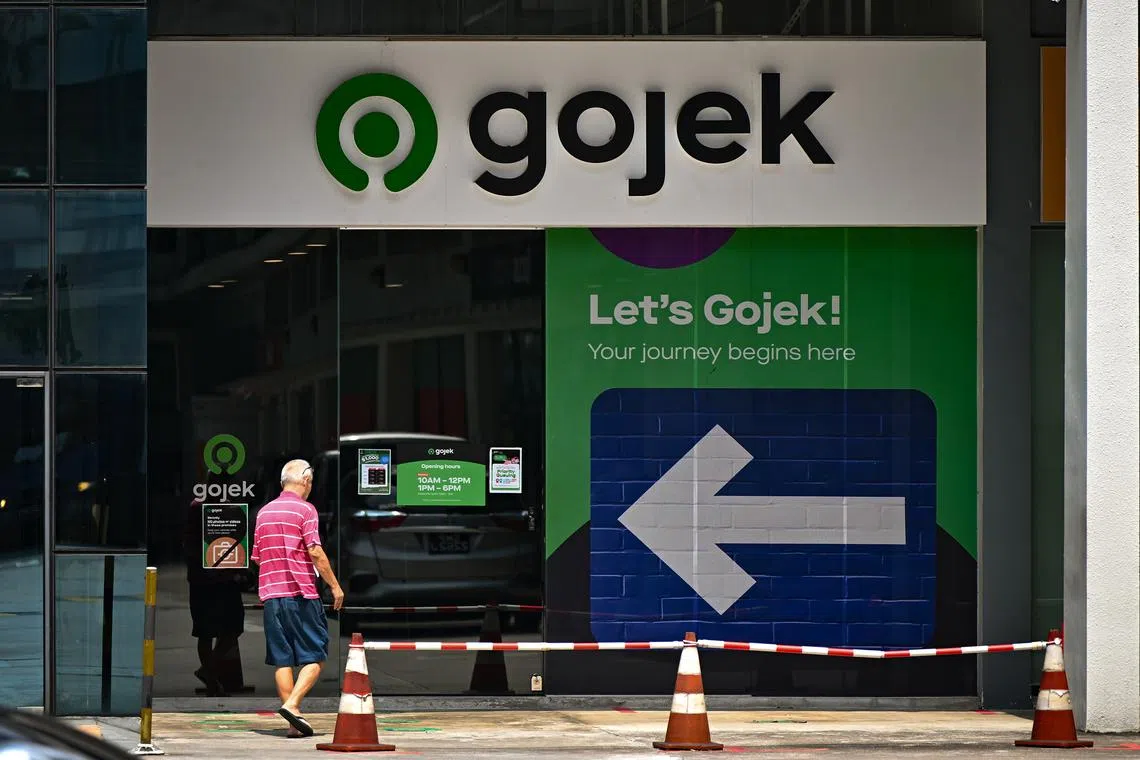Gojek to charge less commission from drivers, but passengers must pay fee for going cashless
Sign up now: Get ST's newsletters delivered to your inbox

Gojek cited the growing demand for ride-hailing services and higher operating costs for drivers as the reasons for reducing its commission rate, or “service fee”.
ST PHOTO: LIM YAOHUI
Follow topic:
SINGAPORE – From Nov 1 until at least the end of 2024, ride-hailing company Gojek will lower the commission that it takes from drivers who use its platform, reducing it from 15 per cent to 10 per cent for every trip.
The move is aimed at tackling an ongoing supply crunch affecting the point-to-point transport sector
On Thursday, Gojek cited the growing demand for ride-hailing services and higher operating costs for drivers as the reasons for reducing its commission rate, or “service fee”.
“Reducing the service fee will help to increase drivers’ take-home earnings while ensuring Gojek’s services remain reliable and accessible for consumers,” said a Gojek Singapore spokeswoman.
Gojek also announced that from Nov 1, there will be an added transaction fee of between 10 cents and 60 cents for passengers who use cashless payment methods for their rides. It is the first time Gojek is introducing such a fee.
The company called this “standard industry practice”, and said the amount charged will be tiered based on distance travelled.
“This will not impact your overall earnings,” the company told its drivers in a blog post on Thursday.
It said the charge will be reflected in customer receipts as a new “payment transaction fee” component. To help offset this fee and increase ridership, the company will offer a new promo code for a 15 per cent discount off Gojek rides, capped at $5, from Nov 1.
The new promotion will run throughout the month of November.
Other changes that will kick in from November include a revised incentive scheme for drivers that will now take into account their ride acceptance rate, which must be at least 60 per cent.
Before the Covid-19 pandemic struck in early 2020, Gojek used to take a 20 per cent cut from its drivers.
This was halved to 10 per cent in June 2021 – a move the company said was meant to boost driver earnings as the ride-hailing sector was being hit hard by the coronavirus.
In February 2023, it raised its driver commission back to 15 per cent,
It said at the time that the 15 per cent commission rate would remain in force for at least 12 months, and the company chose not to restore it to the full 20 per cent due to the high fuel prices and operational costs at the time.
Since then, fuel prices have remained high
Certificate of entitlement premiums have also shot up during this time, hitting new records.
Rival Grab charges its drivers a commission of up to 20.18 per cent, including goods and services tax, while Tada does not charge its drivers any commission. Ryde charges drivers a commission of 10 per cent.
Meanwhile, Singapore’s largest taxi operator, ComfortDelGro, which has its own ride-hailing app, Zig, charges its drivers a commission ranging from 5 per cent to 10 per cent of total fares.
Both ComfortDelGro and Tada also impose transaction fees on passengers who pay using cashless methods, though for ComfortDelGro, this does not apply to its fixed-fare ComfortRide trips.
Tada charges a fee between 1.8 per cent and 3.3 per cent, depending on the payment method. This is not including an additional 24-cent fee for most cards.
For ComfortDelGro, an administrative charge of 10 per cent is added to the total metered fare when paying by credit card. For other cashless methods, such as ez-link, DBS PayLah! and Nets, a 30-cent charge is added.
On Gojek’s move to lower its driver commission rate, private-hire driver Richard Ong said that it is good, but not enough to entice him back to the platform, which he has not used in more than two years.
The 41-year-old said this is because he feels Gojek’s fares are low, many passengers cancel rides, and drivers are made to travel long distances to pick up passengers – sometimes as far as 10km.
On Thursday, Gojek said it has reduced the average pickup distance for drivers by 25 per cent since the start of October. It has also been optimising its pricing to ensure its fares are fair for all.
Video producer Faraz Hussain, 29, who uses Gojek about once a month and pays for the rides with PayLah, said that the added transaction fee for cashless payments would not put him off the ride-hailing service. The availability of drivers and surge pricing are bigger factors for him.
Ms Li Yan Ping, 38, on the other hand, is not willing to pay the extra charge, and the teacher, who uses ride-hailing services almost daily, pays with cash when riding with Tada.
“I rarely use Gojek because it is a lot more expensive than other platforms most of the time,” Ms Li said, adding that she would use the service even less now with the added fee.


